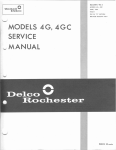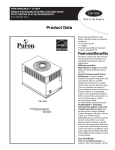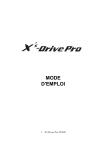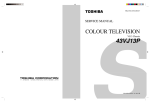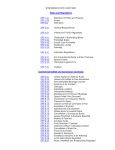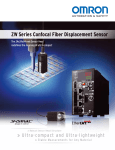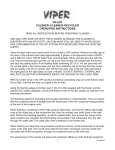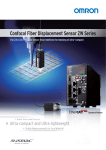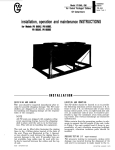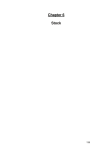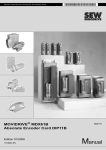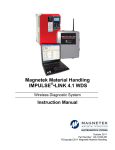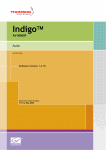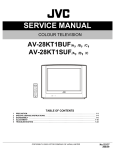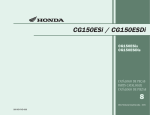Download Chiller, Centrifugal, Models PEH/PHH (02/89) - 1076K
Transcript
SINGLE COMPRESSOR CENTRlFUGAL CHlUERS PEHIPHH 050,063,079,087,100,126 13600 Industrial Park Blvd.. P.O. Bow 1551, Minneapolis, MN 55440 OPERATION OPERATOR RESPONSIBILITIES It is important that the operator become familiar with the equipment and the system before attempting to operate the chiller. In addition to reading this manual the operator should study installation and operation bulletin IM 403 and the control diagram furnished with the unit so that he understands the starting, operating and shutdown sequences as well as the safety shutdown modes. When the McQuay Service technician performs the initial startup of the chiller he will be available to answer any questions and to instruct in proper operating procedures. It is recommended that the operator maintain an operating log for each individual chiller unit. A suggested log sheet is shown on pages 14 and 15 of this manual. In addition, a separate maintenance log should be kept of the periodic maintenance and servicing activities. This McQuay centrifugal chiller represents a substantial investment and deserves the attention and care normally given to keep this equipment in good working order. If the operator should encounter abnormal or unusual operating conditions, it is recommended that a McQuay Service technician be consulted. McQuay conducts training for centrifugal operators at its factory Training Center several times a year. These sessions are structured to provide basic classroom instruction and include hands-on operating and troubleshooting exercises. For further information, contact your McQuay representative. NOMENCLATURE Each centrifugal chiller is assigned a set of identifying numbers which are used to describe the unit features and to identify each individual unit. These four-number groups are stamped on each unit nameplate. A typical nameplate is shown in Figure 1. All inquiries pertaining to operating and servicing of this unit should include all identification numbers. Each of the individual components also have nameplates to provide certain necessary information to the installer and the operator. The compressor nameplate identifies the compressor model, style and serial numbers and includes the electrical characteristics of the compressor motor. The CEO50 compressor nameplate also shows the oil pump electrical characteristics. The condenser and evaporator vessels have nameplates stamped with the maximum working pressure of the vessel. It should be noted that the vessel relief valve maximum settings coincide with the maximum refrigerant side vessel working pressure. NOMENCLATURE CHANGE: The letter “H” has been added behind the first two digits of the model code to signify a hermetic compressor motor. Models PE and PH are synonymous with PEH and PHH respectively. MICROTECH CONTROL PANEL The MicroTech Unit Controller is a microprocessor based control panel designed to initiate the step-by-step start functions of its host centrifugal compressor unit, monitor and regulate the compressor’s capacity, protect it, and sequence the compressor shutdown on temperature demand or in response to a pre-set time. For full information on the features, installation, operation and problem analysis of the McQuay Microprocessor control for Centrifugal chillers, see Installation and Operation Manual IM 403. FIGURE 1. MICROTECH CONTROL PANEL. IM 307 I Page 3 CAPACITY CONTROL SYSTEM The compressor capacity is controlled by the movement of the inlet vanes, opening or closing to permit the correct quantity of refrigerant to enter the wheel or impeller. The vane movement occurs in response to oil flow from the SA or SB solenoid valve which, in turn, respond to a control module signal. This oil flow activates a piston to rotate the vanes. VANE OPERATION The hydraulic system for the vane control operation consists of a 4-way normally open solenoid valve. Oil under pressure is directed by the 4-way valve to either or both sides of the piston depending on whether the control signal is to load, unload or hold. To open the vanes (or load the compressor) solenoid “SA” is de-energized and solenoid “SB” is energized, allowing oil flow from port SA to one side of the piston to then drain through port SB. To close the vanes (unload compressor) valve SB is deenergized and valve SA is energized to move the piston and vanes to unload position. When both solenoid valves SA and SB are de-energized, full oil pressure is directed to both sides of the piston through ports SA and SB, thus the vanes are held in that position. Refer to Figure 3 for solenoid action. Note that both solenoids cannot be energized simultaneously. VANE SPEED ADJUSTMENT The vane speed at which the capacity control vanes open or close is controlled by the rate of oil bleed-off from the vane actuating piston. This bleed-off rate is adjustable by positioning the needle valves on SA and SB solenoid valves located in the lube box. Screwdriver openings in the left side of the lube box permit access. The upper opening accesses the SB needle valve for adjusting the vane OPENING speed for loading the compressor (refer to Figure 2). Turn this screw clockwise to decrease the vane opening speed and counterclockwise to increase the opening speed. The lower opening accesses the SA needle valve for adjusting the CLOSING speed for unloading the compressor. The same adjustment applies. clockwise to decrease closing, counterclockwise to increase vane closing. The vanes are factory set so that from fully closed to fully open positioning of the vanes requires about 3 minutes and about 1 minute from fully open to fully closed. (Exception: CE126 settings are 9 minutes to open and 3 minutes to close). FIGURE 2. LUBE BOX METERING VALVES The speed at which the capacity control vanes are opened or closed can be adjusted to suit system operating requirements. Adjustable needle valves in the oil drain lines are used to control the rate of bleed-off and consequently the “vane speed”. These needle valves are part of the 4-way solenoid valve assembly located in the compressor lube box (Figure 2). The valves are normally factory set so the vanes will move from fully closed to fully open in approximately 3 minutes and from fully open to fully closed in 1 minute (except CE126). The speed should be slow enough to prevent over-controlling and hunting. FIGURE 3. VANE CONTROL SOLENOID OPERATION -LEGEND- Oil Under Pressure 11,1 Oil Sump Pressure COMPRESSOR UNLOADER CYLINDER FLOATING PISTON LINKED TO INLET VANES -+ OPENS VANES f- f - - C L O S E S V A N E S FOUR WAY SOLENOID VALVE LOCATED IN LUBE BOX PISTON DRAIN TO OIL ---_) PUMP SUMP SECTION “SE” DE-ENERGIZED SECTION “SA” DE-ENERGIZED ADJUSTABLE NEEDLE VALVES INTEGRAL WITH FOUR WAY SOLENOID VALVE Page 4 / IM 307 FROM OIL PUMP DISCHARGE -LEGEND- Oil Under Pressure II Oil Sump Pressure w TO OIL SECTION “SB” ENERGIZED SECTION “SA” DE-ENERGIZED DISCHARGE SECTION “SE” DE-ENERGIZED SECTION “SA” DRAIN FROM PISTON OIL SYSTEM The oil system for the PEH/PHH units provides lubrication and heat removal for the compressor bearings and internal parts. In addition, the system provides oil under pressure to hydraulically operate the piston for positioning the inlet guide vanes for capacity control. Proper operation of the hydraulic system and bearing lubrication system can be assured only if McQuay recommended oil is used. For proper oil selection, consult Table 1. Each unit is factory charged with the proper oil. Under normal operation, no additional oil should be needed. The oil pump for the CEO50 compressor is completely selfcontained within the compressor housing. The assembly includes the pump, pump motor, oil heater and oil separator. The oil is pumped through the oil discharge line to the oil filter in the compressor casting and then to the refrigerant-cooled oil cooler. The other compressor sizes-CE063, 079, 087, 100 and 126-utilize a separate oil pump contained in its own oil reservoir. This assembly includes pump, motor, heater and oil separator. Oil is pumped through the discharge line, through the external oil cooler and then to the oil filter inside the compressor housing. Standard PEH/PHH 063-126 units utilize a water-cooled oil cooler although an optional refrigerantcooled oil cooler is available. The oil coolers serve to maintain the proper oil temperature under normal operating conditions. The coolant flow control valve should maintain 9O”F-100°F oil temperature leaving the oil cooler for optimum operation of the oil system. Bearings are supplied with oil through internally drilled passages within the compressor assembly. The oil drains from the bearings into the gear housing and is gravity returned to the oil sump. The oil heaters in the gear case and in the oil pump reser- voir must remain energized whenever the compressor is off. IN THE EVENT OF POWER LOSS TO THE HEATERS ALLOWING THE OIL TO COOL, THE HEATERS SHOULD BE ENERGIZED FOR 24 HOURS PRIOR TO STARTING THE COMPRESSOR. The MicroTech Microprocessor based control panel monitors the oil temperature and prevents the unit from starting with low oil temperature. This prevents refrigerant laden oil from being delivered to the bearings upon start-up. For details see page 24 of Installation & Maintenance Bulletin IM 403 or the MicroTech control panel. The compresssor is equipped with lubrication protection for coast down in the event of a power failure. This is accomplished by the use of a spring loaded piston in models CEO50 thru 100. When the oil pump is started, the piston is forced back by oil pressure, compressing the spring and filling the piston cavity with oil. When the pump stops, the spring pressure on the piston forces the oil out to the bearings. In model CE126 the compressor coast down lubrication is supplied from a gravity feed lube reservoir. TABLE 1. OIL FOR CENTRIFUGAL COMPRESSORS CEO87 CE100 CE126 11.0 12.0 SUNISO 4GS SUNISO 5GS TEXACO WF68 TEXACO WFI 00 SUNISO 5GS TEXACO WF100 TEXACO REGAL 150 SHELL TURBO 150 IM 307 I Page 5 HOTGAS BYPASS The PHH heat recovery chillers are equipped with a hot gas bypass system used to feed discharge gas directly into the evaporator when the system load falls below 10% of the compressor capacity. Light load conditions are signaled by measurement of a set percentage of RLA amps by the MicroTech control panel. When the RLA drops to the hot gas setpoint the hot gas bypass solenoid is energized leaving hot gas bypass available for use. This introduction of hot gas provides a stable refrigerant flow and keeps the machine from short cycling under light load conditions. It also prevents surge during heat recovery operation. The factory setpoint for bringing on hot gas bypass is 40” of RLA. See IM 403, page 33 for details. FIGURE 5. PEH079 CHILLER (REAR VIEW) LEGEND 1. 2. 3. 4. 5. Page 6 / IM 307 Evaporator Pressure Relief Valve Chilled Water Connections Oil Cooler Water Connections Condenser Pressure Relief Valve Oil Cooler 6. Oil Pump Assembly 7. Discharge Line Check Valve 8. Lube (Control Box) 9. Motor Cooling Feed Line 10. Compressor Motor Terminal Box MAINTENANCE ROUTINE MAINTENANCE LUBRICATION (See CAUTION) After the system is once placed into operation, no other additional oil is required except in the event that repair work becomes necessary to the oil pump or unless a large amount of oil is lost from the system due to a leak. If oil must be added with the system under pressure, use a hand pump with its discharge line connected to the service valve at the bottom of the oil pump. (The CEO50 compressor with its internal oil pump is equipped with an oil service valve on the compressor). CHANGING OIL FILTERS (See CAUTION) CEO50 Compressors-If the unit is equipped with a suction line service valve, close this valve and close the valve on the motor cooling liquid line to isolate the compressor. Vent the refrigerant pressure from the compressor. Remove the filter cover and the old filter and install the new filter, open end first. Replace the cover using a new gasket. Reopen the suction and liquid line valves. If the unit is not equipped with a suction line service valve, the unit will have to be pumped down in order to remove the pressure in the compressor before removing the cover and changing the filter. Refer to later section for pumpdown procedure. CEO63 and Larger Compressors-The oil filter in each of these machines can be changed by simply isolating the filter cavities. Close the oil discharge line service valve at the oil pump (at the filter on CE126). Remove the filter cover; some foaming may occur but the check valve should limit leakage from other compressor cavaties. Remove the filter, replace with new element and replace filter cover using new gasket. Reopen valve in pump discharge line. When the machine is operated again, the oil level should be checked to determine if oil needs to be added to maintain proper operating level. CAUTION Improper servicing of the lubrication system, including the addition of excessive or incorrect oil, substitute quality oil filter, or mishandling of the equipment under pressure is hazardous. Only authorized and trained service personnel should attempt this service. For qualified assistance, contact your local McQuay Service technician. REFRIGERANT CYCLE Maintenance of the refrigerant cycle consists of maintaining a log of the operating conditions, and assuring the unit has the proper oil and refrigerant charge. (See the maintenance schedule and the appropriate operating log at the end of this bulletin). At every inspection, the oil, suction and discharge pressures should be noted and recorded, as well as condenser and chiller water temperatures. The suction line temperature at the compressor should be taken at least once a month. Subtracting from this, the saturated temperature equivalent of the suction pressure will give the superheat. Extreme changes in superheat over a period of time will indicate losses of refrigerant or possible deterioration of the expansion valves. Proper superheat setting is 2” to 6°F at full load. ELECTRICAL SYSTEM Maintenance of the electrical system involves the general requirement of keeping contacts clean and connections tight and checking on specific items as follows: 1. The compressor current draw should be checked and compared to nameplate RLA value. Normally the actual current will be lower since the nameplate rating represents full load operation. Also check all pump and fan motor amperages and compare with nameplate ratings. 2. Inspection should verify that the oil heaters are operative. The heaters are insert cartridge type and can be checked by ammeter reading. They should be energized whenever power is available to the control circuit (whenever compressor is inoperative). When the compressor starts the heaters are de-energized. 3. At least once a quarter, all safety controls except compressor overloads should be made to operate and their operating points checked. Any control may shift its operating point as it ages, and this must be detected so the controls can be readjusted or replaced. Pump interlocks and flow switches should be checked to assure they interrupt the control circuit when tripped. 4. Contactor in the motor starter should be inspected and cleaned quarterly. Tighten all terminal connections. 5. The compressor motor resistance to ground should be checked and logged semi-annually. This log will track insulation deterioration. A reading of 5 megohms or less indicates possible insulation failure and should be further checked. 6. The centrifugal compressor must rotate in the direction indicated by the arrow on the casting near the rotation sightglass. If the operator has any reason to suspect that the power system connections may have been altered, the compressor should be jogged to check rotation. For assistance, call McQuay Service. CLEANING AND PRESERVING A common cause of service calls and equipment malfunction is dirt. This can be prevented with normal maintenance. The system components most subject to dirt are: Permanent or cleanable filters in the air handling equipment must be washed in accordance with the manufacturer’s instructions; throwaway filters should be replaced. The frequency of this service will vary with each installation. Remove and clean strainers in chilled water system, oil cooler line and condenser water system at every inspection. SEASONAL SERVICING Prior to shutdown periods and before starting again, the following service procedures should be completed. ANNUAL SHUTDOWN 1. Where freezing temperatures may be encountered, the Page 8 / IM 307 condenser and chiller water piping should be disconnected from the supply and drained of all water. Dry air blown through the condenser will aid in forcing all water out. Removal of condenser heads is also recommended. The condenser and evaporator are not self-draining. Water per- mitted to remain in the piping and vessels will rupture these parts if subjected to freezing temperature. FORCED CIRCULATION OF ANTIFREEZE THROUGH THE WATER CIRCUITS IS THE ONLY SURE METHOD OF AVOIDING TROUBLE. 2. Take measures to prevent the shutoff valve in the water supply line from being accidentally turned on. 3. If a cooling tower is used and if the water pump will be exposed to freezing temperatures, be sure to remove the pump drain plug and leave it out so that any water which may accumulate will drain away. 4. Open compressor disconnect switch, and remove Fusetrons. If transformer is used for control voltage, the disconnect must remain on to provide power to oil heater. Set the manual stop/auto switch (SWI) to the stop position. To insure against the possibility of an accidental start, remove the fault relay from the left side of the MicroTech panel (see Figure 2, page 4 of IM 403). 5. Check for corrosion and clean and paint rusted surfaces. 6. Clean and flush water tower for all units operating on a water tower. Make sure tower “blowdown” or bleedoff is operating. Set up and use a good maintenance program to prevent “liming up” of both tower and condenser. It should be recognized that atmospheric air contains many contaminants which increase the need for proper water treatment. The use of untreated water may result in corrosion, erosion, sliming, scaling or algae formation. It is recommended the service of a reliable water treatment is required-McQuay assumes no responsibility for the results of untreated or improperly treated water. 7. Remove condenser heads at least once a year and clean condenser tubes. ANNUAL STARTUP A dangerous condition can exist if power is applied to a faulty compressor motor starter which has been burned out. This condition can exist without the knowledge of the person starting the equipment. This is a good time to check all the motor winding resistance to ground. Semi-annual checking and recording of this resistance will provide a record of any deterioration of the winding insulation. All new units have well over 100 megohms resistance between any motor terminal and ground. Whenever great discrepancies in readings occur or uniform readings of less than 5 megohms are obtained, the motor cover should be removed for inspection of the winding prior to starting the unit. Uniform readings of less than 5 megohms indicate motor failure is imminent and motor should be replaced or repaired. Repair before failure occurs can save a great deal of time and labor expended in the cleanup of a system after motor burnout. 1. The control circuit should be energized at all times. If the control circuit has been off and oil is cool, energize oil heaters and allow 24 hours for heater to remove refrigerant from the oil before starting. 2. Check and tighten all electrical connections. 3. Replace the drain plug in cooling tower pump if it was removed at shutdown time the previous season. 4. Install Fusetrons in main disconnect switch (if removed). 5. Reconnect water lines and turn on supply water. Flush out condenser and check for leaks. 6. Refer to Service Manual SM001, Centrifugal System Checkout & Start-up information, and IM 403 before energizing the compressor circuit. REPAIR OF SYSTEM PUMPING DOWN If it becomes necessary to pump the system down, extreme care should be used to avoid damage to the water chiller due to freezing. Always make sure that full water flow is maintained through the chiller while pumping down. To pump system down, close all liquid line valves. With all liquid line valves closed and water flowing through chiller, start the compressor. Set the MicroTech panel to the manual load (see IM 403). The vanes must be open while pumping down to avoid a surge or other damaging condition. Pump the unit down until the mechanical low pressure switch (MLP) cuts out at 25 psig. Use a portable condensing unit to complete the pump down, condensate the refrigerant, and pump it into the condenser. psig and adding sufficient dry nitrogen to bring the pressure up to a maximum of 125 psig and then leak test with Halide or electronic leak detector. CAUTION: DO NOT USE OXYGEN TO BUILD UP PRESSURE AS A SERIOUS EXPLOSION CAN RESULT. A pressure regulating valve should always be used on the drum being used to build the system pressure. Also, do not exceed the test pressure given above. When the test pressure is reached disconnect the gas cylinder. If any leaks are found in welded or silver soldered joints or if it is necessary to replace a gasket, relieve the test pressure in the system before proceeding. For copper joints, silver solder is recommended. After making any necessary repair, the system should be evacuated as described below. PRESSURE TESTING No pressure testing is necessary unless some damage was incurred. After repairs are made, pressure test the system at a pressure that does not exceed the standby pressure in the condenser. (A test pressure higher than condenser pressure would open the discharge check valve and allow flow of test pressure into condenser). In cases where the entire refrigerant charge is lost, refer to the following paragraphs. The evacuation procedure can be followed in both cases. EVACUATION After it has been determined that there are no refrigerant leaks, the system should be evacuated using a vacuum pump with a capacity of approximately 3 cu. ft/min. and that will reduce the vacuum to at least 1 millimeter (1000 microns). A mercury manometer, electronic or other type of micron gauge should be connected at the farthest point from the vacuum pump. For readings below 1 millimeter, the electronic or other micron gauge should be used. The triple evacuation method is recommended and is particularly helpful if the vacuum pump is unable to obtain the desired 1 millimeter of vacuum. The system is first evacuated to approximately 29 inches of mercury. Enough refrigerant vapor is then added to the system to bring the pressure up to zero gauge pressure. Then the system is once again evacuated to approximately 29 inches of mercury. This is LEAK TESTING In case of the loss of the entire refrigerant charge, the unit should be checked for leaks prior to charging the complete system. This can be done by charging only enough refrigerant into the system to build the pressure up to approximately 10 IM 307 / Page 9 repeated 3 times. The second pull down will remove about 90% of that remaining from the first pull down and after the third, only 1110 of 1% non-condensables will remain. REFRIGERANT CHARGING The McQuay centrifugal chillers normally use R-l 2, or R-500 refrigerant; therefore, it is recommended that the operator check the unit nameplate to assure the correct refrigerant selection prior to charging or adding refrigerant. An initial operating charge is made at the factory prior to shipment. In the event the operator needs to add refrigerant after the unit is installed, certain precautions should be taken to protect equipment components. Refrigerant charging lines must be kept dry, clean and free of non-condensable gases. Care should be taken in selecting the best charging point in the unit so as to protect the equipment from damage. If the entire charge is lost or removed from the unit, recharging can be accomplished quickly and safely by introducing the liquid refrigerant directly into the bottom of the evaporator with the expansion valve manually opened. Both condenser water and chilled water must be flowing through the respective vessels to prevent localized freezing. Consult the chiller nameplate for the proper refrigerant charge. With a near-normal charge in the system, final charging can best be accomplished with the unit running with the compressor at full load. In this operating mode the unit should be charged until suction superheat is between 2” and 6”F, adjusting the thermal expansion valve as necessary. Continue charging until 9” to 11 “F liquid subcooling is obtained leaving the condenser if the unit is operating at full load. At less than full load, liquid subcooling will be proportionally less. PRESSURE RELIEF VALVE REPLACEMENT Current condenser designs use two relief valves (1 set) separated by a three-way shutoff valve. In the event one of the relief valves is leaking on the two valve set, the following procedures should be followed: If the valve closest to the valve stem is leaking, back seat the three-way valve all the way, closing the port to the leaking pressure relief valve. Remove and replace the faulty relief valve. The three-way shutoff valve should remain either fully back seated or fully forward for normal operation. If the relief valve furthest from the valve stem is leaking, front seat the three-way valve and replace the relief valve and replace the relief valve as stated above. EQUIPMENT WARRANTY Each PEH/PHH centrifugal chiller manufactured by McQuay carries a standard limited warranty. This warranty covers repair or replacement of component parts which prove defective in material or workmanship within 12 months from initial startup or 18 months from date shipped by the company, whichever comes first. For a complete description of this warranty refer to the warranty form furnished with the equipment. EVAPORATOR & CONDENSER FLOW LIMITS Page 10 / IM 307 McQUAY SERVICE PROGRAMS It is important that an air conditioning system receive adequate maintenance if the full equipment life and full system benefits are to be realized. Maintenance should be an ongoing program from the time the system is initially started. A full inspection should be made after 3 to 4 weeks of normal operation on a new installation and on a regular basis thereafter. McQuay offers a variety of maintenance services through its Nationwide Service Organization and can tailor these services to suit the needs of the building owner. Most popular among these services is the McQuay Comprehensive Maintenance Plan wherein McQuay assumes full responsibility for your air conditioning equipment. Included are regular routine inspections and emergency service by factory trained technicians. All parts, labor, materials, and refrigerant are included in a McQuay Comprehensive Maintenance Contract. For further information concerning the many services available, contact your local McQuay Service representative.

















